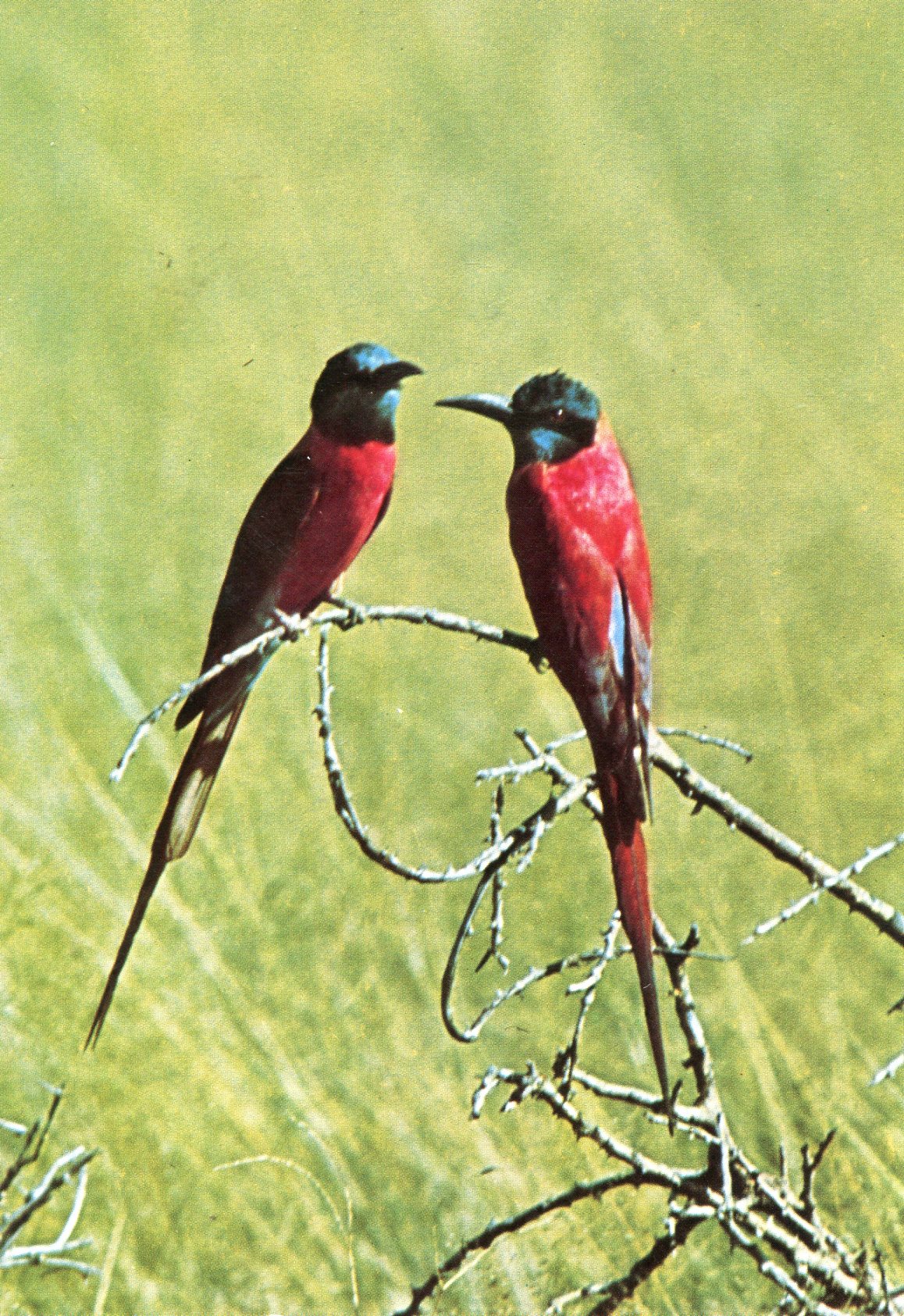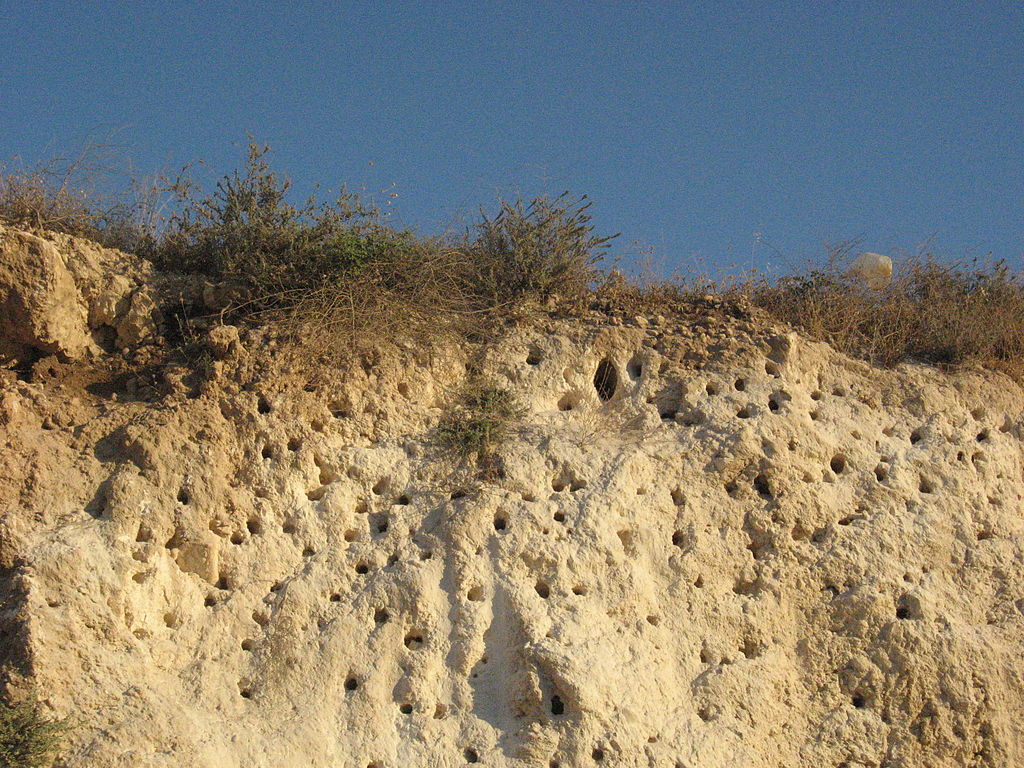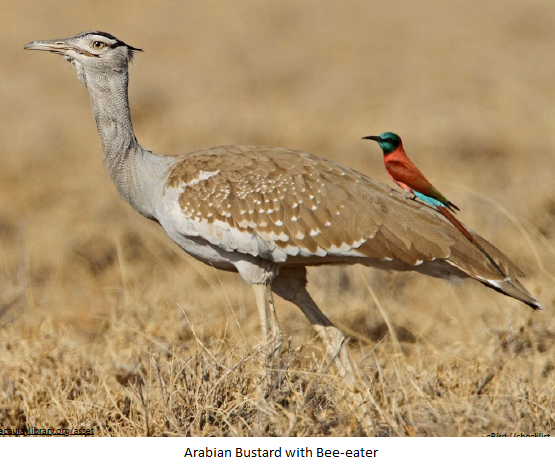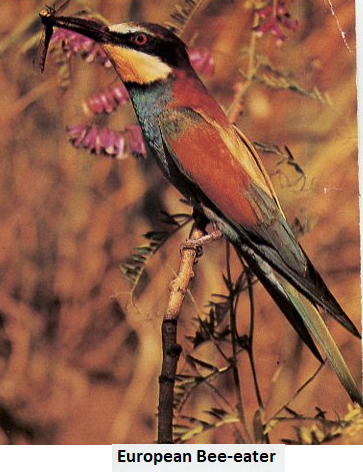Jim Thompson
If you live in southern Europe, Africa, Madagascar, Australia, India and New Guinea, you might see the brightly colored birds called bee-eaters. There are 27 different species of bee-eaters and yes, they do eat honey bees as well as other flying insects. The main fear among beekeepers is that a bee-eater may catch the queen honey bee when she takes her mating flight. Bee-eaters normally consume about 250 bees and other flying insects per day. Bee-eaters have been recorded eating beetles, mayflies, stoneflies, cicadas, termites, crickets, grasshoppers, mantises, true flies and moths. However, they find butterflies distasteful. The largest part of their diet is bees and wasps, with the average being 70% of their diet. It is wise in picking your apiary site so it is not close to the bee-eater colonies. Hives that are placed under trees and overhead power lines have a higher risk as bee-eaters attack insects from their perches.
Bee-eaters typically mate for life and live in long nesting burrows about one meter long that are excavated each year. A burrow could be reused but is usually not because it might be occupied by other birds, snakes and bats. Look for the burrows in excavated earth or river sand banks. One report mentioned that an estimated 10,000 bee-eaters lived in a colony in Africa. It has been found that some migratory bee-eaters may find new mates each breeding season. The average lifespan for a bee-eater living in the wild is five to six years. The size of the bee-eater is from six inches to 14 inches and is a mid-sized bird.
The nests will have two to nine eggs, with the average of five. Both parents take care of the young and sometimes helpers, which are males from a previous hatch. The incubation starts soon after the first egg is laid and it hatches in about 20 days. Because the eggs hatch at different times, the older chicks have the tendency to survive as the food supply may be short. The chicks stay in the nest for about 30 days.
In hunting food, some bee-eaters ride on the back of “beaters” which stir up grasshoppers, dragonflies and other prey. The beaters could be elephants, donkeys, goats, Kori bustards or Arabian bustards. Sometimes the bustards feed on similar food such as locusts, grasshoppers, beetles, reptiles and small mammals. So the bee-eater might choose to sit on a perch rather than ride and swoop down on their insects from the perch.
To eat a stinging insect, the bee-eater removes the sting by hitting the insect on a hard surface to kill it and then wipe the insect’s abdomen on the perch to discharge the sting.
In Africa, some of the bee-eaters feed upon stingless bees.
Bee-eaters may be killed by raptors or their nests could be raided by rodents and snakes. Sometimes the bee-eater carry parasites such as blood-feeding flies, biting flies, chewing lice and stickfast flies.
Meropidae of bee-eaters is divided into three genera. Nyctyornis with two large species, Meropogon which has the Purple-bearded Bee-eater as a sole member and Merops has all the other species. Merops bee-eaters have a black bar across the eyes.
The naming of the bee-eaters was done in 1815 by Samuel Rafinesque-Schmaltz, a French polymath Constantine who created the subfamily Meropia. The name is now modernized as Meropidae from the Greek word Merops and the English term bee-eater.
Sub species of Bearded bee-eaters – Nyctyornis thinae
- Red-bearded Bee-eater, Nyctyornis amictus – Asia
- Blue-bearded Bee-eater, Nyctyornis athertoni – Asia
- Meropogon bee-eater
- Purple-bearded Bee-eater, Meropogon forsteni – Indonesia
- Third group of bee-eaters, Merops
- Little Bee-eater, Merops pusillus
- Blue-cheeked Bee-eater, Merop persicus – Africa
- Little Green Bee-eater, Merops orientalis – Africa
- White-throated Bee-eater, Merops albicollis – Africa
- Swallow tailed Bee-eater, Merops hirundineus – Africa
- Blue-tailed Bee-eater, Merops philippinus
- Black Bee-eater, Merops guiaris – Africa
- Blue-headed Bee-eater, Merops muelleri – Africa
- Blue-moustached Bee-eater, Merops mentalis – Africa
- Red throated Bee-eater, Merops bulocki – Africa
- White fronted Bee-eater, Merops bullockoides – Africa
- Blue-breasted Bee-eater, Merops variegates – Africa
- Cinnamon-chested Bee-eater, Merops oreobates – Africa
- Black-headed Bee-eater, Merops breweri – Africa
- Somali Bee-eater, Merops revoilii – Africa
- Boehm’s Bee-eater, Merops boehmi – Africa
- Blue throated Bee-eater, Merops viridis
- Olive or Madagascar Bee-eater, Merops superciliosus – Africa & Europe
- Rainbow Bee-eater, Merops ornatus – Australia
- European Bee-eater, Merops apiaster – Africa & Europe
- Chestnut-headed Bee-eater, Merops leschenaultia
- Rosy Bee-eater, Merops malimbicus – Africa
- Northern Carmine Bee-eater, Merops nubicus – Africa
- Southern Carmine Bee-eater, Merops nubicoides – Africa
Bee-eaters in culture:
“In Greek mythology, the Theban Botres was fatally struck by his father when he desecrated a ritual sacrifice of a ram to the god Apollo by tasting the victim’s brains. The god took pity of him, turning him into a bee-eater.
The Ancient Egyptians believed that bee-eaters had medical properties, prescribing the application of bee-eater fat to deter biting flies, and treating the eyes with the smoke from charred bee-eater legs to cure an unspecified female complaint.
In Hinduism, the shape of the bird in flight was thought to resemble a bow, with the long bill as an arrow. This led to a Sanskrit name meaning “Vishnu’s bow” and an association with archer gods. Scandalmongers were thought to be reincarnated as bee-eaters, because of the metaphorical poison they bore in their mouths.
Depictions in classical art are rare for such striking birds. The only known Ancient Egyptian example is a relief, probably of a little green bee-eater, on a wall of Queen Hatshepsut’s mortuary temple, and an early Roman mural depicting blue-cheeked bee-eaters was found in the villa of Agrippina. Bee-eaters have been depicted on the postage stamps of at least 38 countries, the European and Carmine bee-eaters being the most common subjects, with 18 and 11 countries respectively.”














